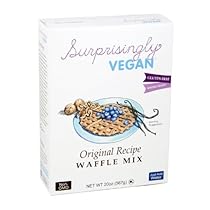Breakfast is a piece of cake; I mastered that very quickly. Dinners are where I struggled. Incidentally, they're the most important part of my Celiac life. See, Dinners are quickly turned into lunches when properly planned, which makes life so much easier.
For years, I awkwardly prepared food, with no real direction. I'd wander around the store, buying things that looked good. Inevitably, food would spoil or I'd make a meal and the flavors wouldn't really jive.
It probably didn't help that I'm not much of a recipe follower; I have the uncontrollable urge to substitute.
My ultimate goal is to be one of those people who can take what's in the fridge and come up with something delicious. I suppose I could rephrase that to say that my ultimate goal is to cook like my mother, who has mastered the art of taking random ingredients and throwing them together into a mouthwatering masterpiece.
Ironically, my culinary success started when I started planning my meals in advance. It's a good way to build a solid cooking foundation.
I started simply with this basic meal formula:
A. Meat
B. Vegetable
C. Grain
Groundbreaking, I know. But, it works when you've got no other inspiration.
I took inspiration from the grocery store's weekly sale flyers. I sat down at the table with the flyer and made myself one of these:
And then I followed these steps:
A. Pick a meat that's on sale. Write it down for Monday. Do the same for the rest of the days of the week with a different sale meat. Don't think about it. Just write it down. Monday, we're having chicken. Tuesday, beef. Bam. The basis for each meal is set.
- Pick a way to prepare that meat. This is where I would use the magic of Google if I didn't have anything already in mind. Keep it simple-- no mixes or condensed soups, which frequently contain gluten anyway. This is where I will again mention the wonders of fresh herbs. And the crock pot.
B. Pick a vegetable that's on sale. Write that down for Monday. Do the same for the rest of the days of the week with a different sale vegetable. This is a great way to eat seasonal, and to try new things. If there are no desirable veggies on sale, grab a bag of frozen veggies.
- Pick a way to prepare that vegetable. Generally, steaming or sauteeing with a bit of butter, garlic, & salt is a winner.
C. Pick a grain to pair with the meal.
- Noodles, rice, or mashed potatoes are good standard options.
Embellish the meals by adding other things that are on sale in the flyer. If peppers are on sale, they get incorporated into Monday's chicken and suddenly stir fry with broccoli and rice is on the menu.
I do try to incorporate things that I already have into the week's menu. For example if we've got an excess of cheese, I'll make sure to use it up by making mac & cheese or cheesy rice.
And yes, I do literally write this stuff down. Here is our menu for the last two weeks.
For instance, on Sunday we're having steak and baked potatoes (which will be topped with cheese, chives, butter, and sour cream).
I can use the leftover sour cream for the beef stroganoff on Monday, and I bought an extra potato to use in Wednesday's vegetable soup, along with the leftover chives.
I don't always plan meals that use up each other's leftovers every week. Sometimes, it just happens that way and it's an added bonus.
Also notice that we didn't get around to eating the vegetable soup and sandwiches the first week, so that got transferred over to the next week.
Also, it's easy to switch around the days. If we feel like eating pork tacos on Tuesday, we would just eat shrimp on Wednesday. Either way, there's enough food for the week.
There it is. Beginner meal planning.



.jpg)

.jpg)






